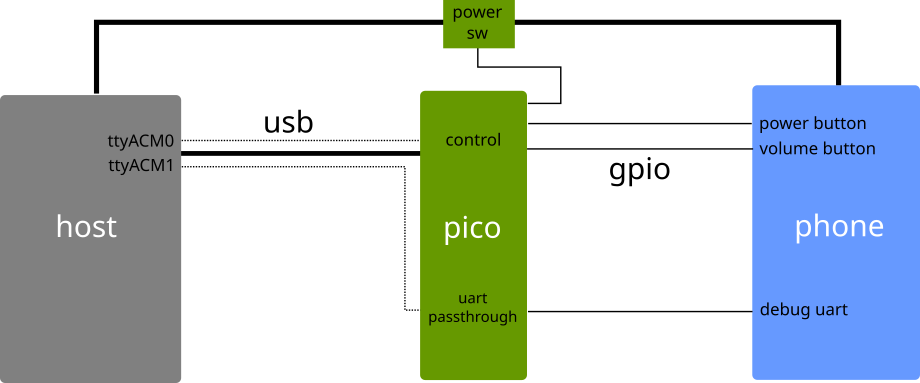This is the firmware for the Raspberry Pi Pico that is providing the interface between the control computer and the phone under test.
The task of the Pico device is to automate pressing the buttons on the device and act like an USB to UART adapter for the serial debug port. The Pico also has the ability to switch off the power to the phone by interrupting the power lines in the USB connection.
The Pico firmware uses tinyusb to create two USB ACM devices that will show up as two USB serial devices on the host machine. The first port is used to send commands to the firmware to control buttons and power. The second port is passed through to hardware UART lines hooked up to test points in the phone.
The firmware has a very simple control protocol, based on the protocol that is used by CDBA. The protocol works by sending commands as single characters. The commands are:
P - Enable power to the device
p - Disable power to the device
B - Press the power button
b - Release the power button
R - Hold the key to enter the bootloader
r - Release the key to enter the bootloader
The uppercase character is always used to enable a function and lowercase to disable it.
The firmware will not echo the commands or respond. Only when an invalid command is sent an error message will be returned.
The second ttyACM device created by the firmware emulates a standard USB-to-UART
converter and passes through to uart1 of the Pico. The port defaults to
the 9600-8-N-1 mode expected by most operating systems. At the moment it's
only possible to change the baudrate, not the start and stop bits.
Firmware pinout:
| pin | function |
|---|---|
| GP2 | Power button |
| GP3 | Flashing button (volume down or up) |
| GP4 | Uart passthrough TX |
| GP5 | Uart passthrough RX |
| GP22 | External power enable |
This project was funded through the NGI0 PET Fund, a fund established by NLnet with financial support from the European Commission's Next Generation Internet programme, under the aegis of DG Communications Networks, Content and Technology under grant agreement No 825310.
